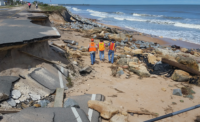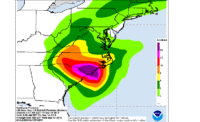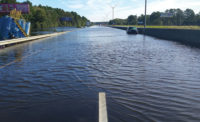As Hurricane Michael charges through the southeast on Thursday, Oct. 11 on its way across Georgia, the Carolinas and southern Virginia, it continues to pack 50 mph gusts and is spawning a few tornados, and flash floods as well. It is expected to strengthen slightly again as it begins to near the Atlantic Ocean.
The storm is downing trees, taking out power lines and spreading wreckage in its wake. Damage to power utility infrastructure mounted fast during the day, going from an estimated 500,000 to 600,000 customers in mid morning to more than one million customers without power across the Southeast by mid afternoon. More than 30,000 power crews from multiple states are staged to move in for restoration,
Meanwhile in the Florida Panhandle officials say they haven’t even had time yet to start taking stock of the damage. “We’re in search and rescue mode,” says a spokeswoman at the Florida Office of Emergency Management.
“We’re focused on the people and getting them to safety,” she said.
Construction Interrupted
The hurricane passed directly over Georgia Power Co.’s Plant Vogtle in Waynesboro, Ga. Georgia Power issued a statement saying, “Due to potential weather impacts from Hurricane Michael, regular work activities will not be performed at the Vogtle 3&4 construction site on Thursday, Oct. 11. Weather permitting, work is expected to resume at the site on Thursday night.” The Bechtel project currently is estimated to cost $27 billion, with completion scheduled in November 2021 for Unit 3 and November 2022 for Unit 4.
Property and casualty insurers are unable to estimate costs for damage to any construction projects until claims are filed, says David Hilgen, spokesman for Zurich Insurance Group. “We can’t give an estimate on Hurricane Florence yet,” he says. Before offering estimates, adjustors have to visit affected sites and reliable estimates often are not announced before the end of a quarter.
Damage Reports
News reports from the coast speak of absolute devastation in beach towns near Mexico Beach, where the storm made landfall. Tyndall Air Force Base, which is nearby, reports “The base has sustained extensive damage,” according to a release posted Thursday morning on the website of the 325th Fighter Wing that is based there.
“The storm brought down trees and power lines. It removed roofs from buildings and caused significant structural damage. The conditions of the runway are unknown at this time,” the release states. The base public affairs office could not be reached for comment. Telephone calls would not go through.
The base, which houses 3,000 people, was evacuated prior to the storm's arrival. No injuries have been reported. Officials advised personnel to expect to be off base for an extended time.
The Naval Facility Command Southeast provides civil engineering support to Tyndall AFB and has staff engaged there as well as in Panama City, according to a NAVFAC spokesman.
Other reports from the area indicate widespread damage in Panama City, about 11 miles to the east of where the center came ashore. Videos from Panama City posted on social media show trees stripped of branches or thrown down and ranks of utility poles flattened. A stretch of Interstate 10 is reportedly closed by debris.
Federal Response
Mexico Beach took a direct hit, but the Federal Emergency Management Agency has not yet been able to get in and conduct assessments. In Oct. 10 and 11 briefings a spokesperson said FEMA's focus still is on search and rescue, after which they’ll turn to restoring supply chains and “lifelines”—power, communications, infrastructure, commodities, etc.
House Appropriations Chairman Rodney Frelinghuysen said on Oct. 11, that FEMA "currently has sufficient funds for immediate disaster response,” but promised the committee will act quickly if more is needed and promised “we will ensure that resources are available to help with recovery and rebuilding efforts.”
-- Power: Duke Energy in the Carolinas had nearly 180,000 customers without power, but the numbers were still climbing by mid afternoon as the storm began exiting the region. Early damage estimates showed more than 3,000 damaged poles and downed lines.
Large utilities and cooperatives had outages totaling one million, with Georgia Power the hardest hit with 200,000 customers knocked out. Early assessments show 2,600 “trouble cases,” of downed lines and broken poles.
Utilities were assessing damage on Thursday and expected to have a better idea of the damage by Friday, but some have warned that it could take weeks to restore power in the worst hit areas.
Tallahassee’s city utility said thousands of trees were down causing “the most widespread and severe damage” the city had ever seen. More than 114,000 customers were without power and about 60% of its transmission system was damaged, city officials said.
The primary objective Thursday was to clear roads for electric crews to begin rebuilding damage to the transmission and distribution system. About 97% of the city’s customers were without power. In the surrounding area, 48,000 of Talquin Electric’s 52,000 customers were without power.
Gulf Power, a Southern Company affiliate that serves the Florida Panhandle, said it is possible it will have to rebuild the system to restore power.
Early in its assessment, the utility said it had at least 2,700 cases of broken poles and downed power lines. “The Gulf Power system held strong from Pensacola to Fort Walton Beach, a testament to the investment we made in infrastructure, a spokesman said. Panama City to the Georgia line was hit hard, he said.
Southern Company reduced power at both units of the 1,751 MW Farley nuclear plant located 90 miles north of the Gulf Coast, and within the path of the storm. The action was taken as a precautionary measure, the company’s nuclear affiliate said. No updates were available on Thursday.
The U.S. Army Corps of Engineers has generators staged at Maxwell AFB in Montgomery, Ala. It expects to relocate some to Elgin AFB, closer to Pensacola, to reduce deployment time.
-- Dams, Levees and Ports: According to Ray Alexander, USACE Director for Contingency Operations, Before the storm made landfall the Corps assessed more than 29 flood risk management projects. All reservoirs were found to have sufficient reserve capacity to handle the expected rainfall. No deviations from current reservoir release schedules are expected. The ports of Panama City, Pensacola, and Cedar Key are closed. Ports in Georgia and Carolinas are open, but with restrictions.
-- Relief: The Corps is moving people and equipment toward the damage zone and beginning to conduct assessments. It plans to focus on housing, infrastructure, debris removal, and water management needs. The Corps has 80 personnel deployed to the affected area and has pre-positioned 55 generators with an additional 30 generators on the way. Maxwell AFB is one of the incident support bases for Michael. FEMA typically partners with military to use facilities for staging, etc., but has teams co-located with Florida’s Department of Emergency Management in Tallahassee, and in Atlanta to manage logistics.
The U.S. Dept. of Defense's Northern Command reports it has positioned commercial power-supply vehicles in teams at the Marine Corps Logistics Base in Albany, Ga., and added critical supplies, commodities and high-water vehicles at three locations, Maxwell Air Force Base, Ala.; North Aux-Field, S.C.; and Fort Bragg, North Carolina -- the same incident staging bases that are part of the ongoing Hurricane Florence recovery efforts.
The Defense Logistics Agency has pre-positioned fuel supplies at Maxwell Air Force Base and other areas, along with 145 additional generators.
FEMA: No Strain On Our Resources
Jeff Byard, FEMA's associate administrator for response and recovery says the agency is up to the task. “We’re a coordinating agency and can utilize the full scope of the federal government as needed," he says, adding that there are some advantages to Hurricane Michael hitting within FEMA Region IV, the same region Hurricane Florence hit in September. "It’s the same region, so we know how agencies operate. But there’s no strain on our resources. If another storm were to occur next week, we’d be ready for it," he says.
Weather experts at the National Oceanic and Atmospheric Administration expect widespread, moderate to major flooding will reoccur in the Carolinas as Michael moves through. Large areas of those states still are waterlogged from Hurricane Florence. But flooding effects will be limited, forecasters predict, because the system is moving quickly and the flooding won’t last as long. There is an enhanced risk for tornados, however, they say.
FEMA administrator Brock Long says Michael’s forward speed should means less rainfall than was experienced with Florence, although some areas may see rainfall totals of as much as 9 in., and isolated downpours can still be tough for some riverine systems to handle. He adds, also, that there still is the potential for 2 ft to 4 ft storm surge on North Carolina's Pamlico Sound as Michael nears the coast tonight.
“It’s not over,” Long says.









Post a comment to this article
Report Abusive Comment